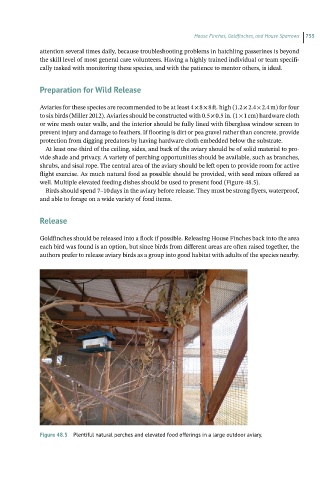Page 753 - Hand rearing birds second
P. 753
House Finches, Goldfinches, and House Sparrows 755
attention several times daily, because troubleshooting problems in hatchling passerines is beyond
the skill level of most general care volunteers. Having a highly trained individual or team specifi-
cally tasked with monitoring these species, and with the patience to mentor others, is ideal.
Preparation for Wild Release
Aviaries for these species are recommended to be at least 4 × 8 × 8 ft. high (1.2 × 2.4 × 2.4 m) for four
to six birds (Miller 2012). Aviaries should be constructed with 0.5 × 0.5 in. (1 × 1 cm) hardware cloth
or wire mesh outer walls, and the interior should be fully lined with fiberglass window screen to
prevent injury and damage to feathers. If flooring is dirt or pea gravel rather than concrete, provide
protection from digging predators by having hardware cloth embedded below the substrate.
At least one‐third of the ceiling, sides, and back of the aviary should be of solid material to pro-
vide shade and privacy. A variety of perching opportunities should be available, such as branches,
shrubs, and sisal rope. The central area of the aviary should be left open to provide room for active
flight exercise. As much natural food as possible should be provided, with seed mixes offered as
well. Multiple elevated feeding dishes should be used to present food (Figure 48.5).
Birds should spend 7–10 days in the aviary before release. They must be strong flyers, waterproof,
and able to forage on a wide variety of food items.
Release
Goldfinches should be released into a flock if possible. Releasing House Finches back into the area
each bird was found is an option, but since birds from different areas are often raised together, the
authors prefer to release aviary birds as a group into good habitat with adults of the species nearby.
Figure 48.5 Plentiful natural perches and elevated food offerings in a large outdoor aviary.

